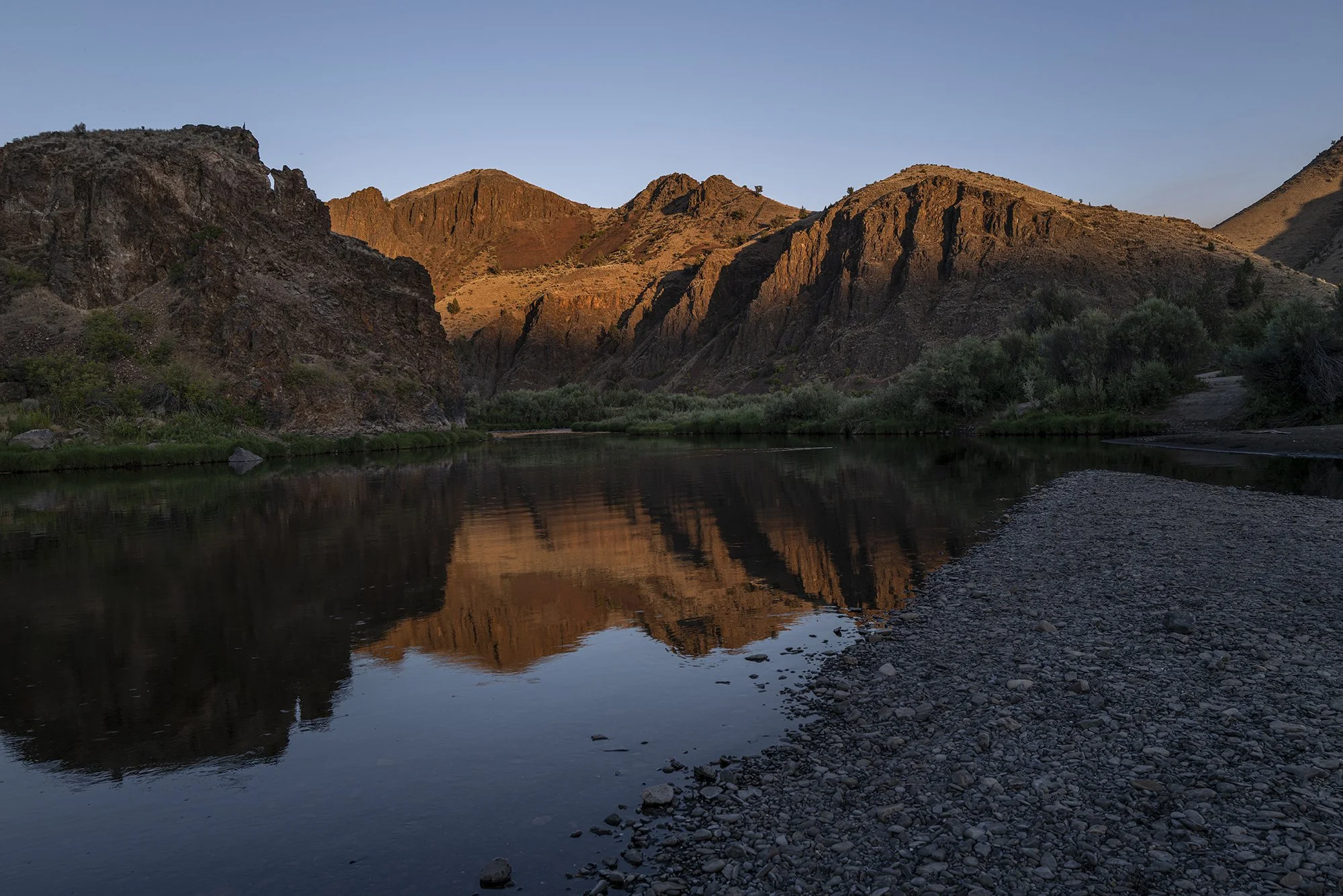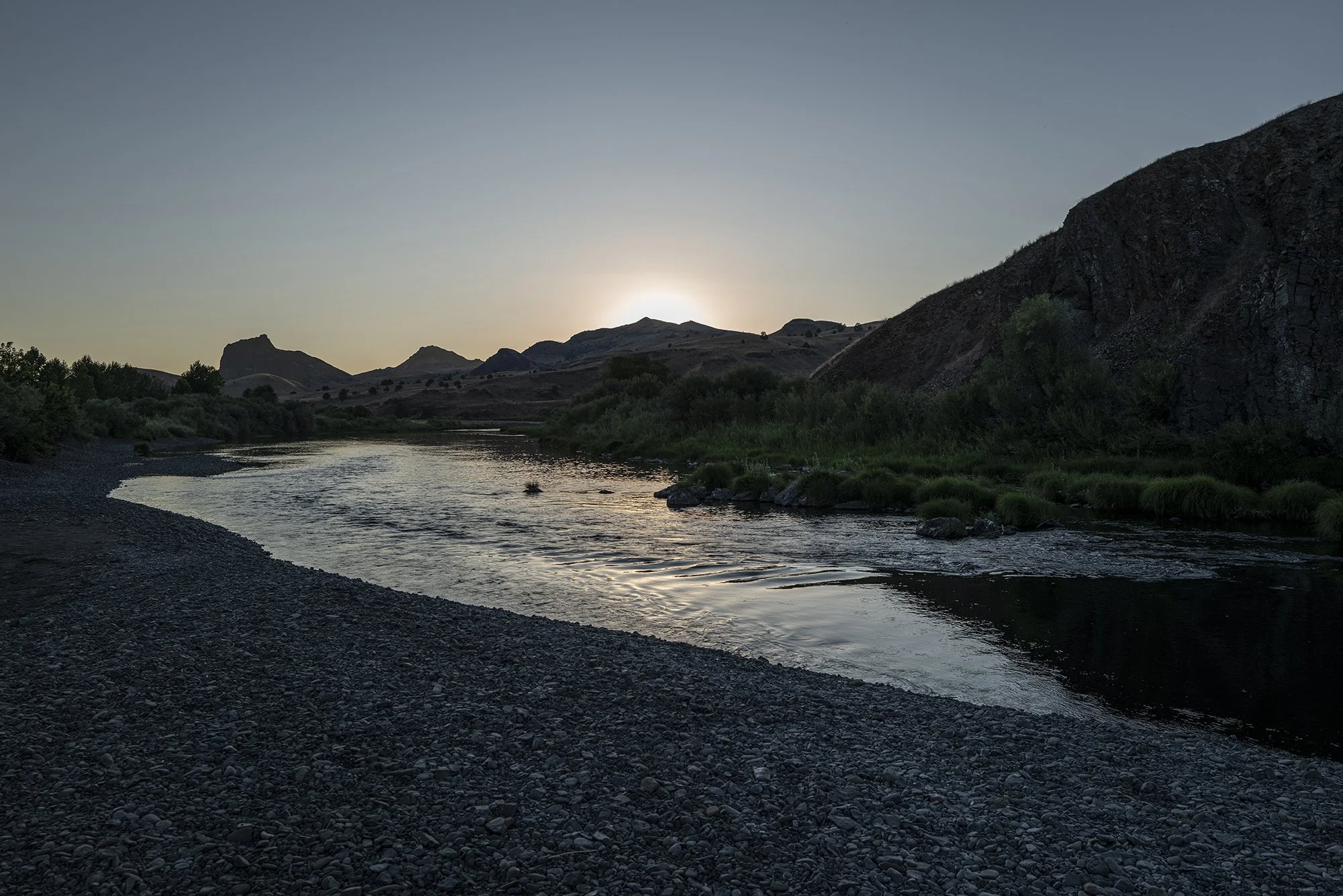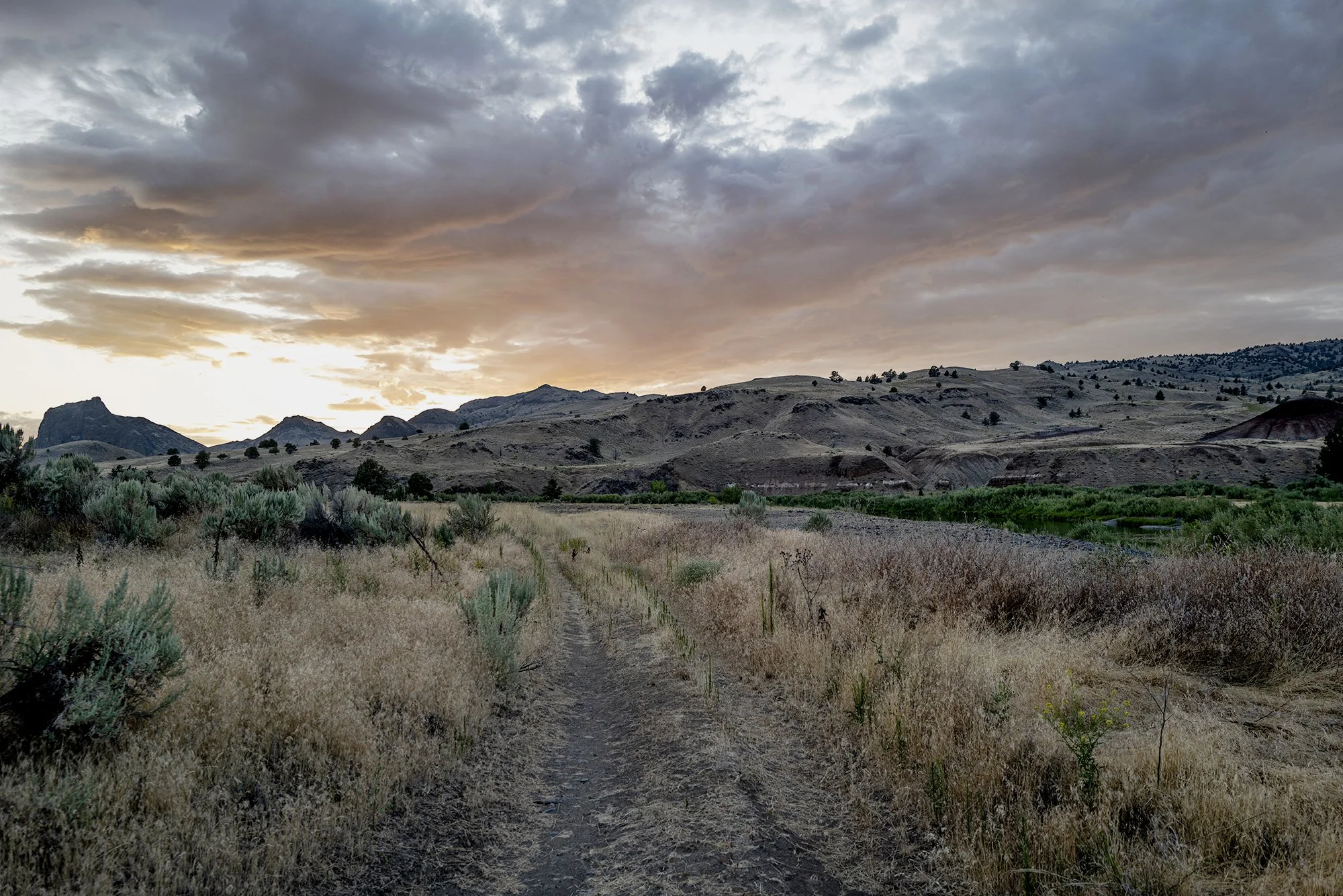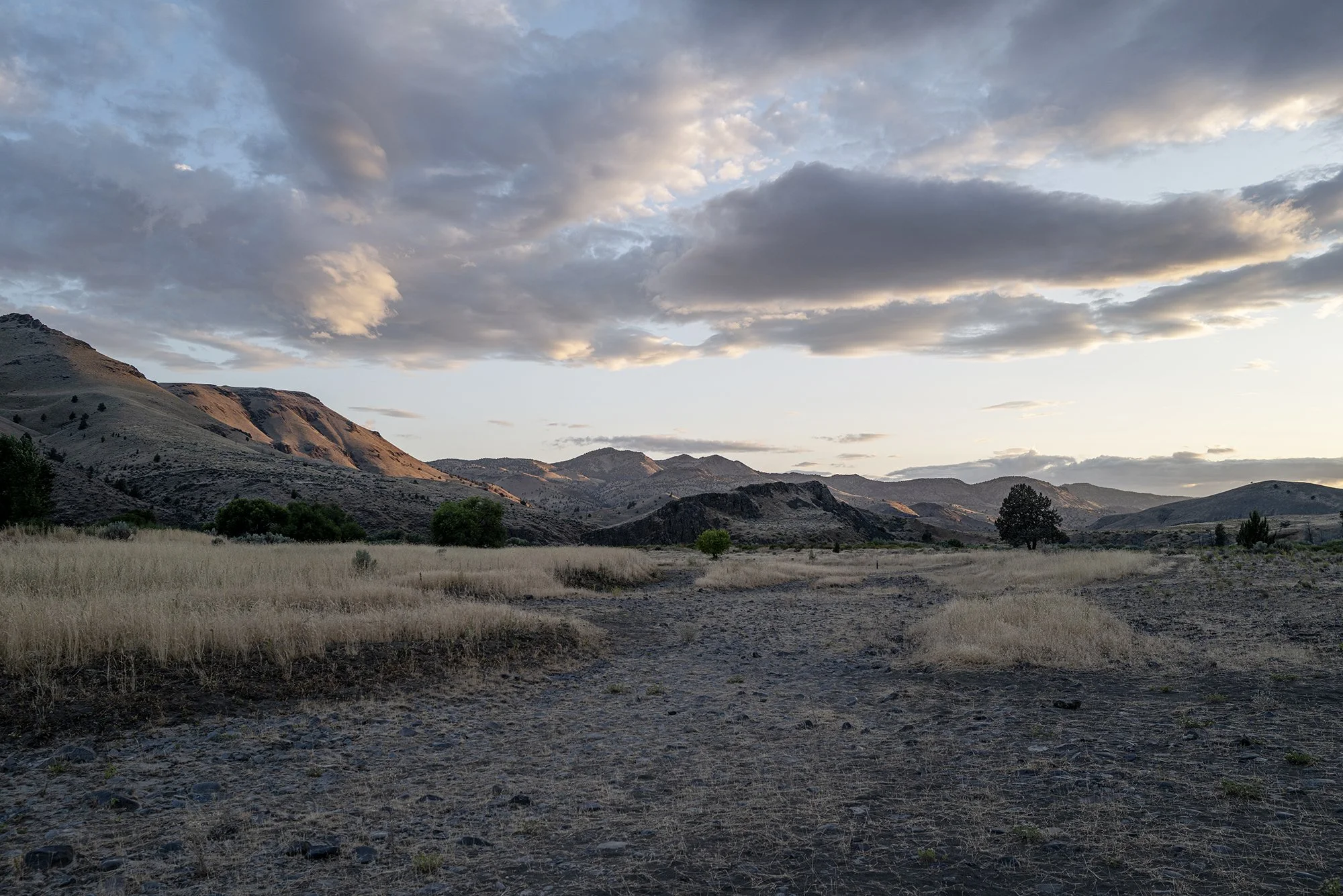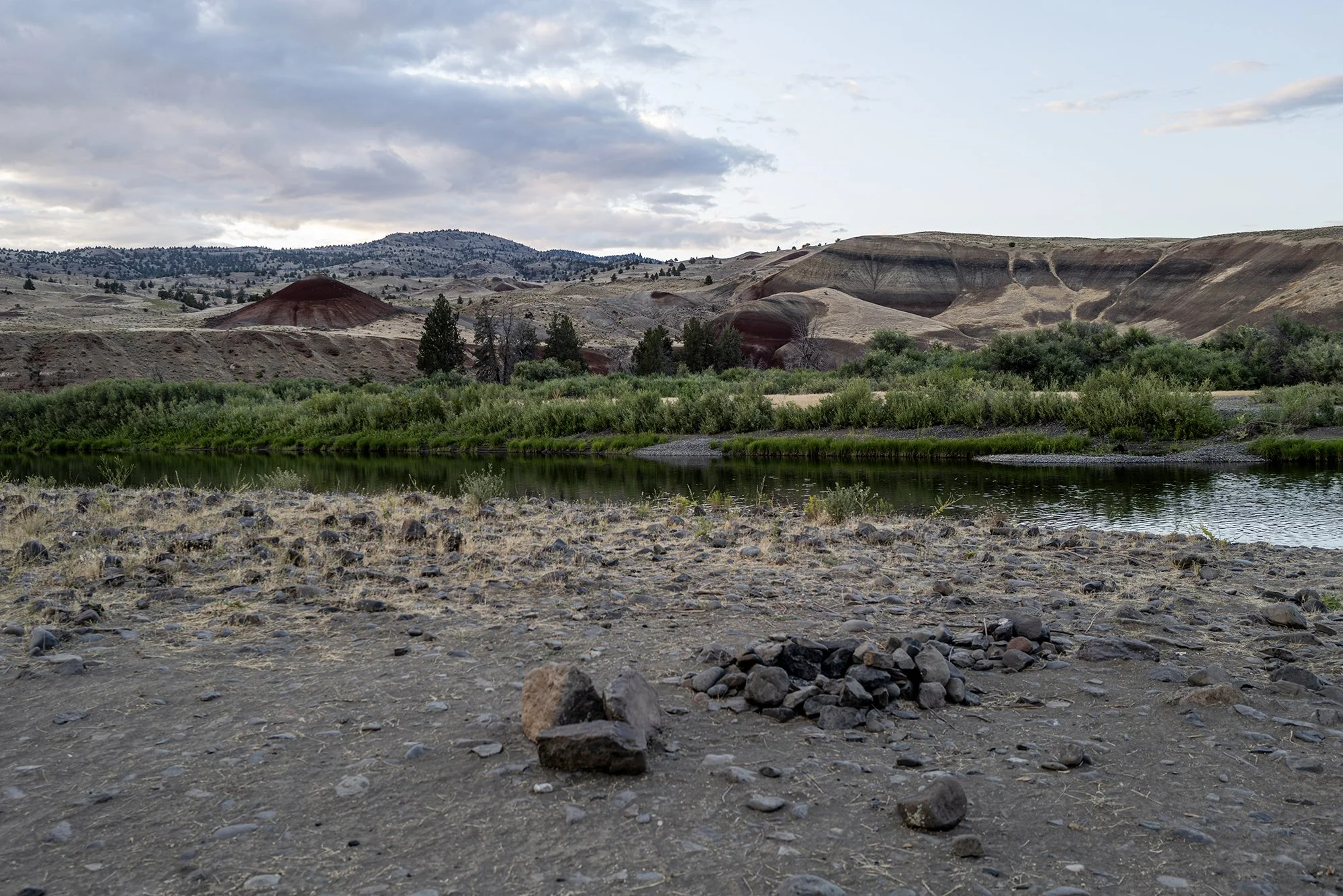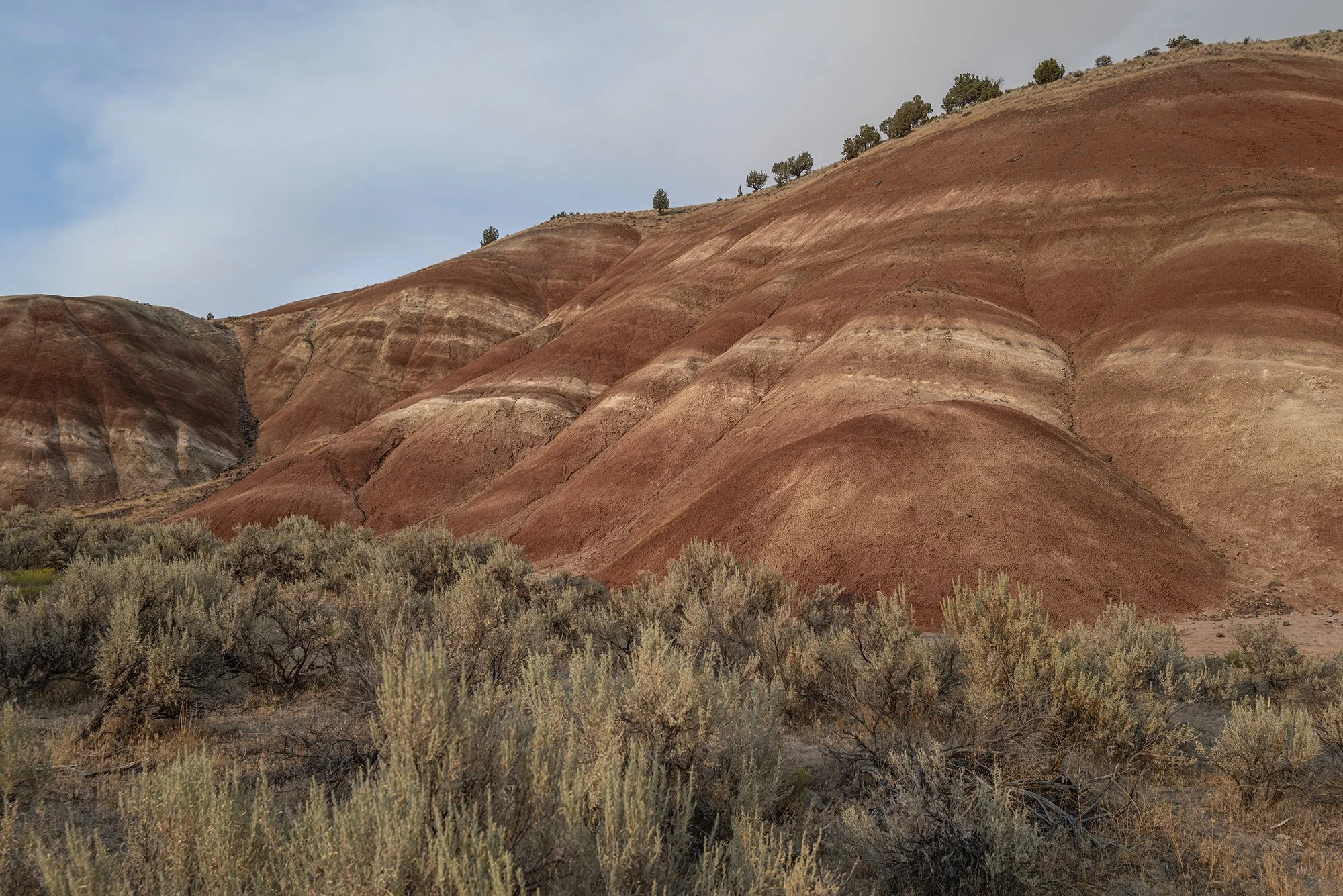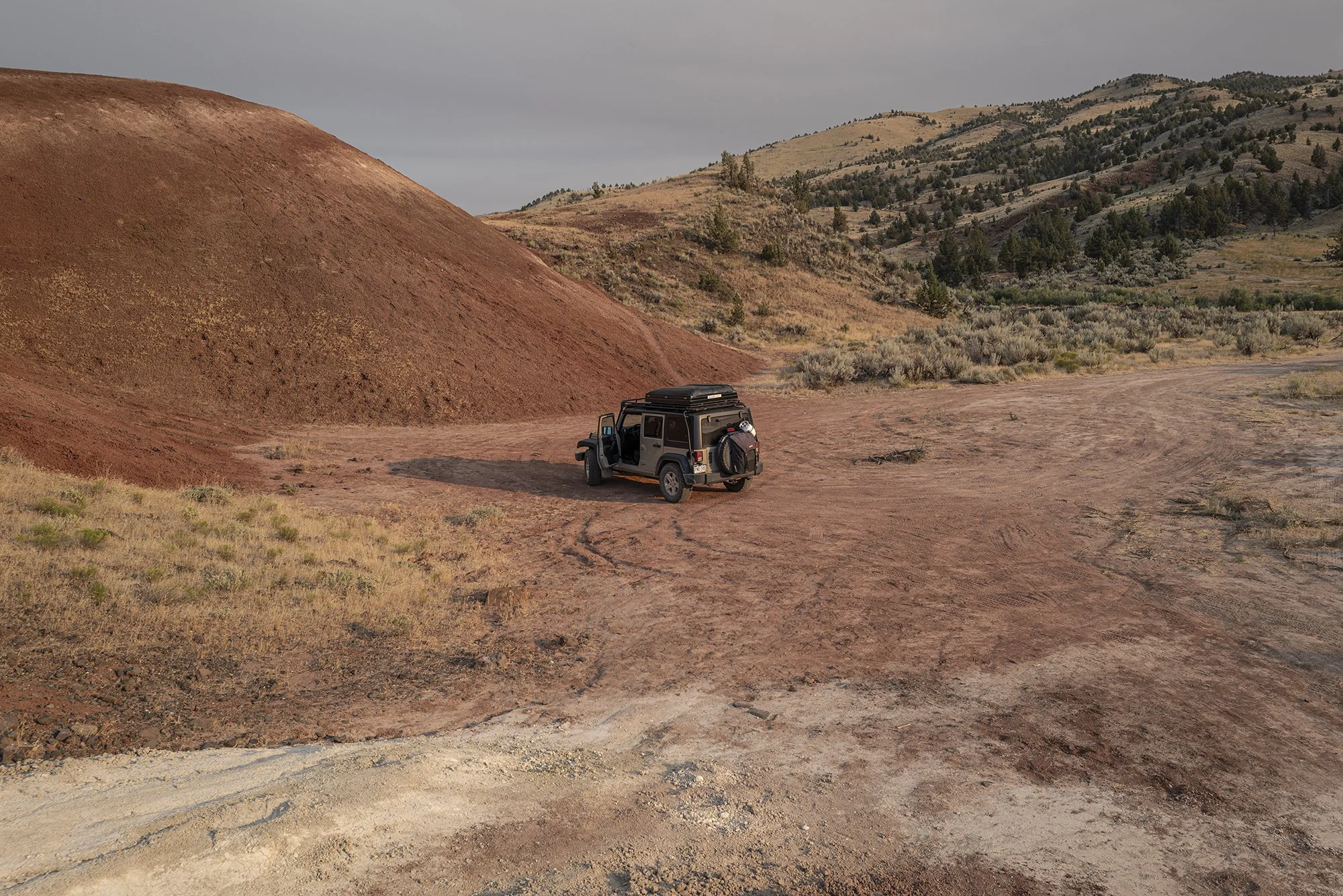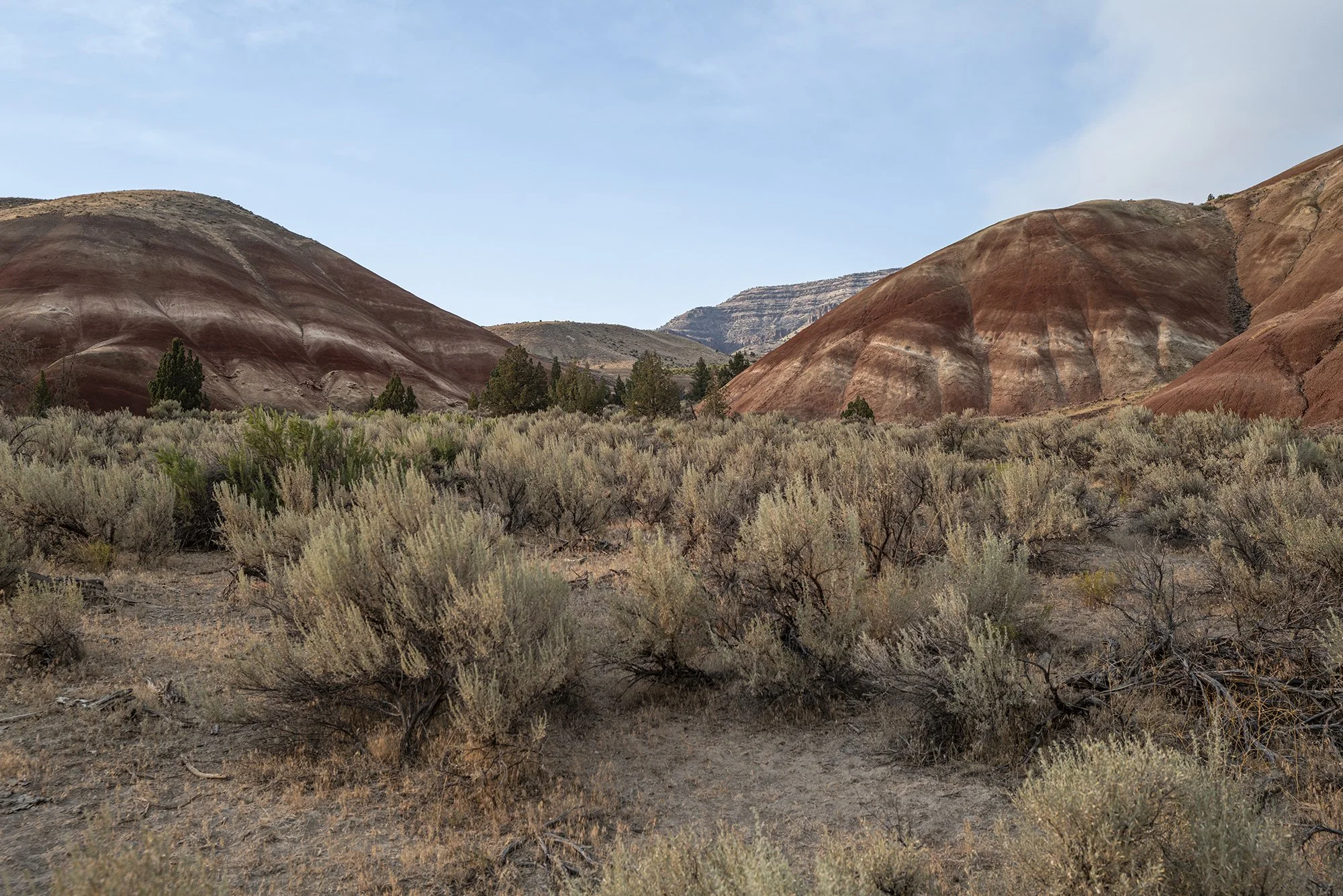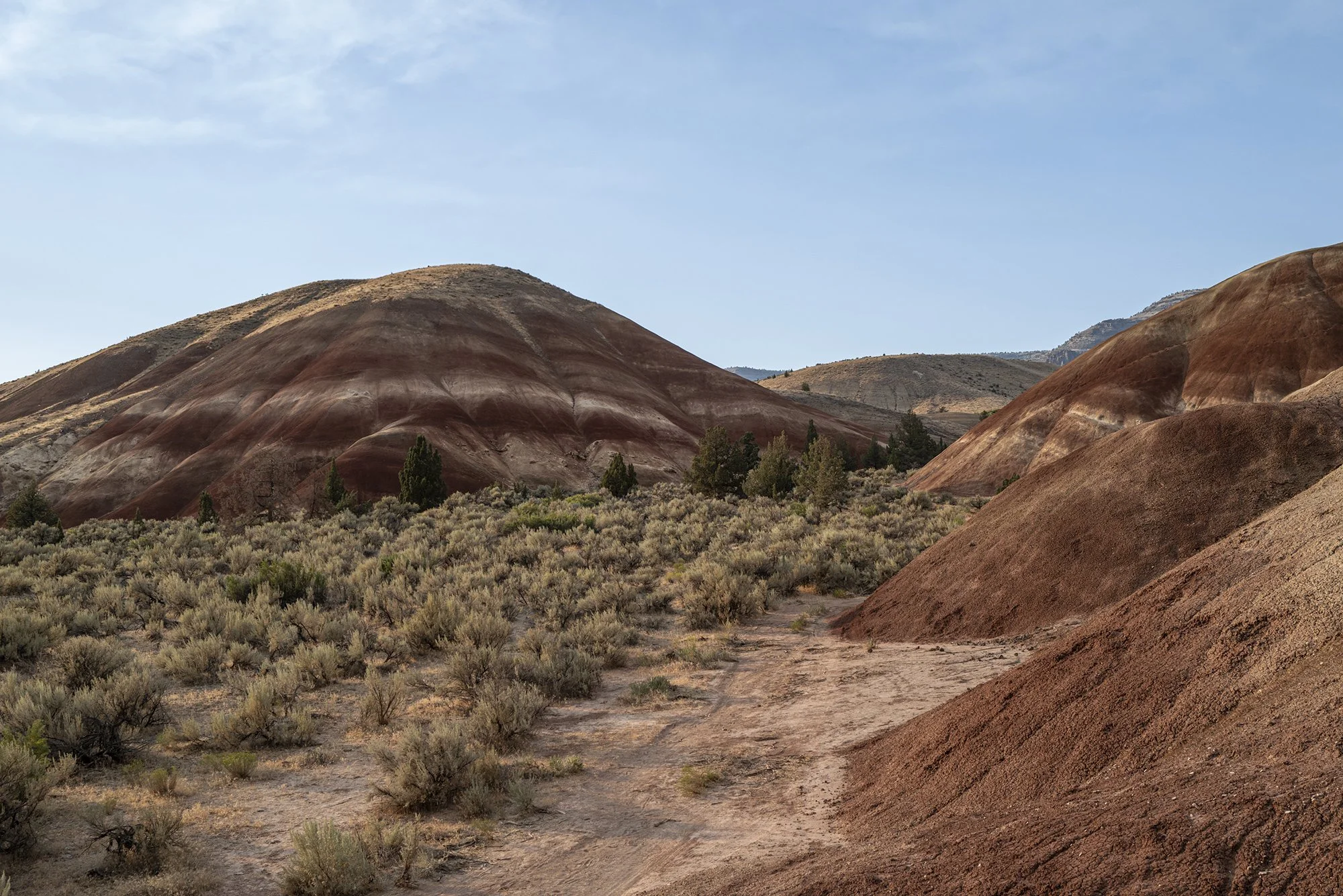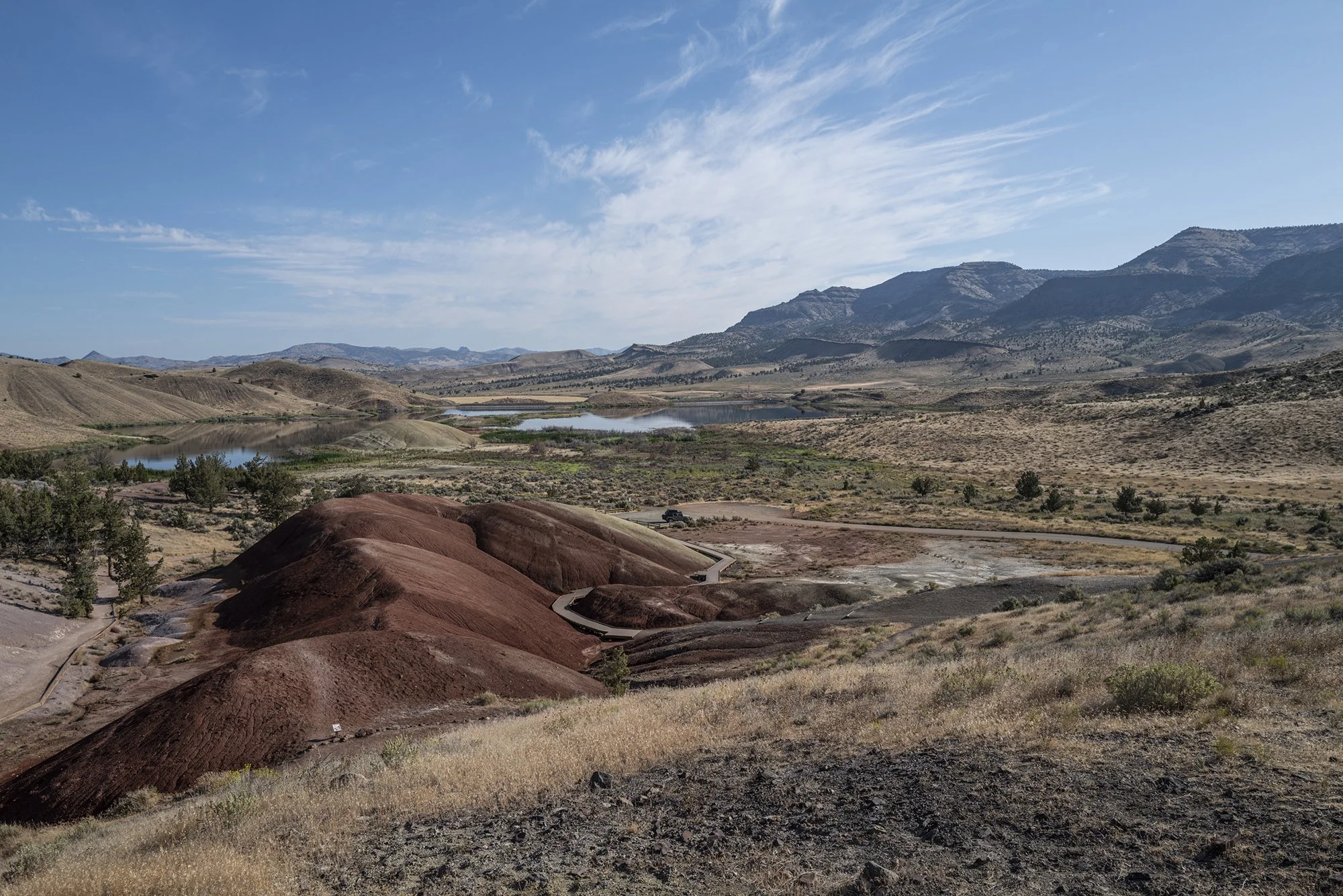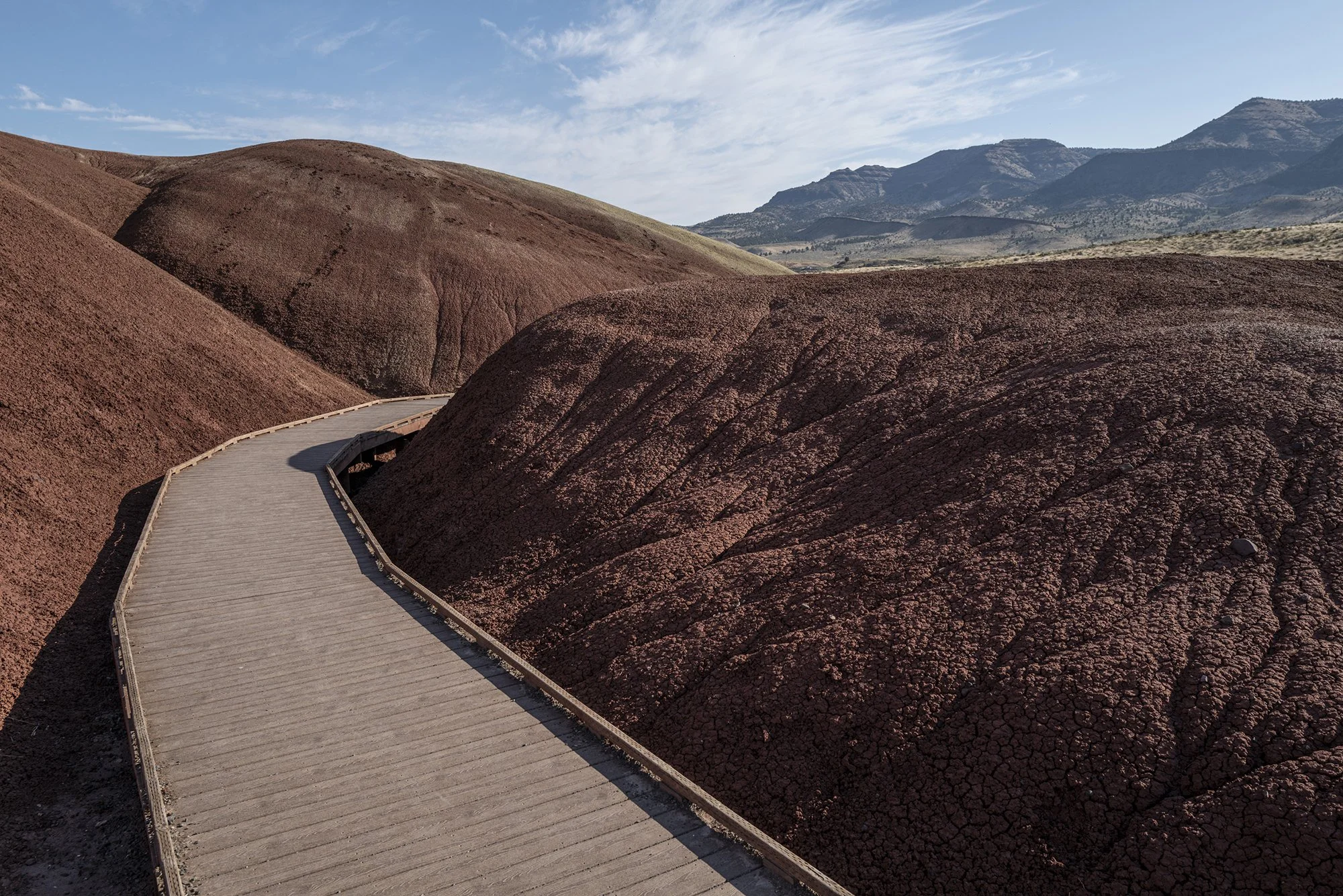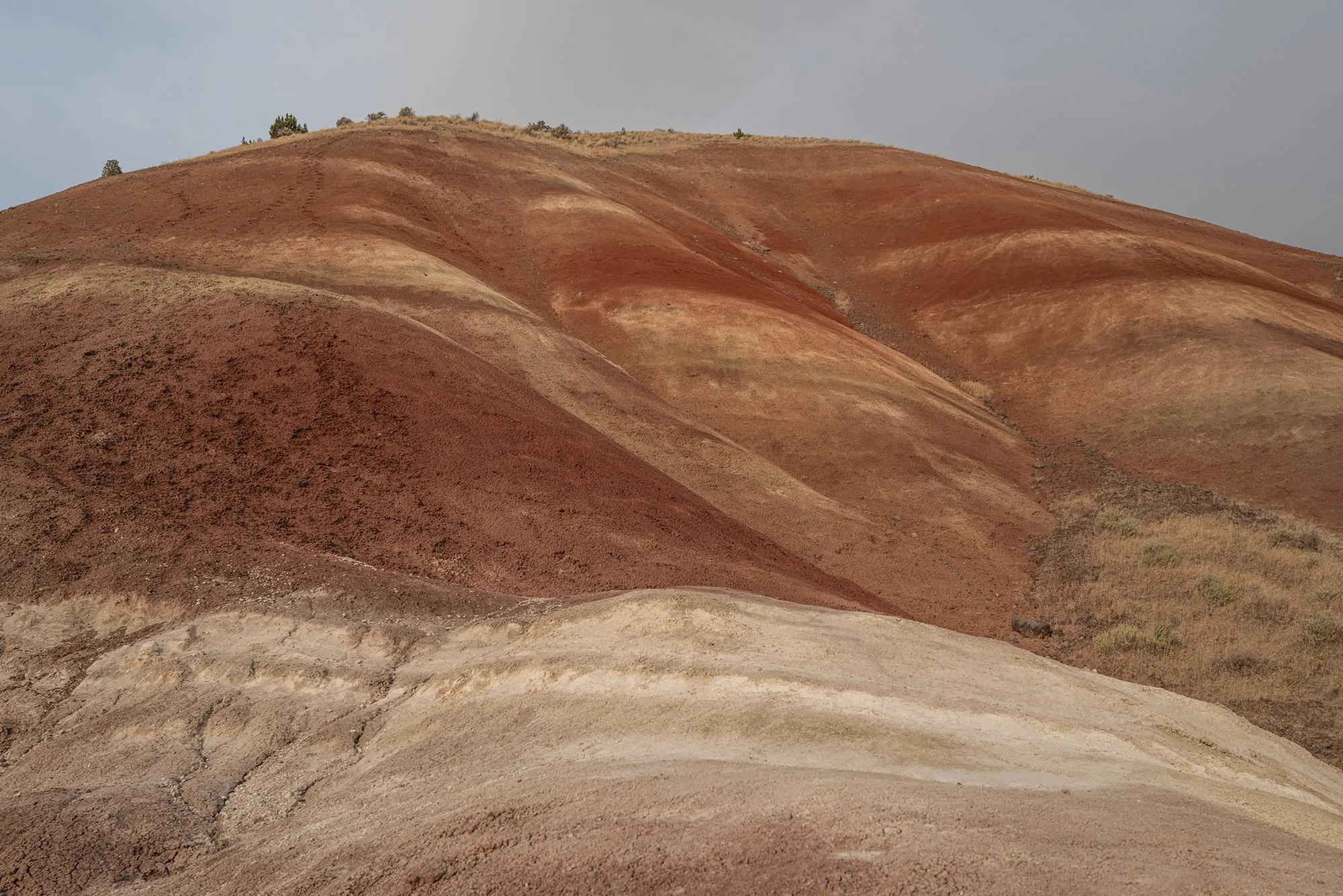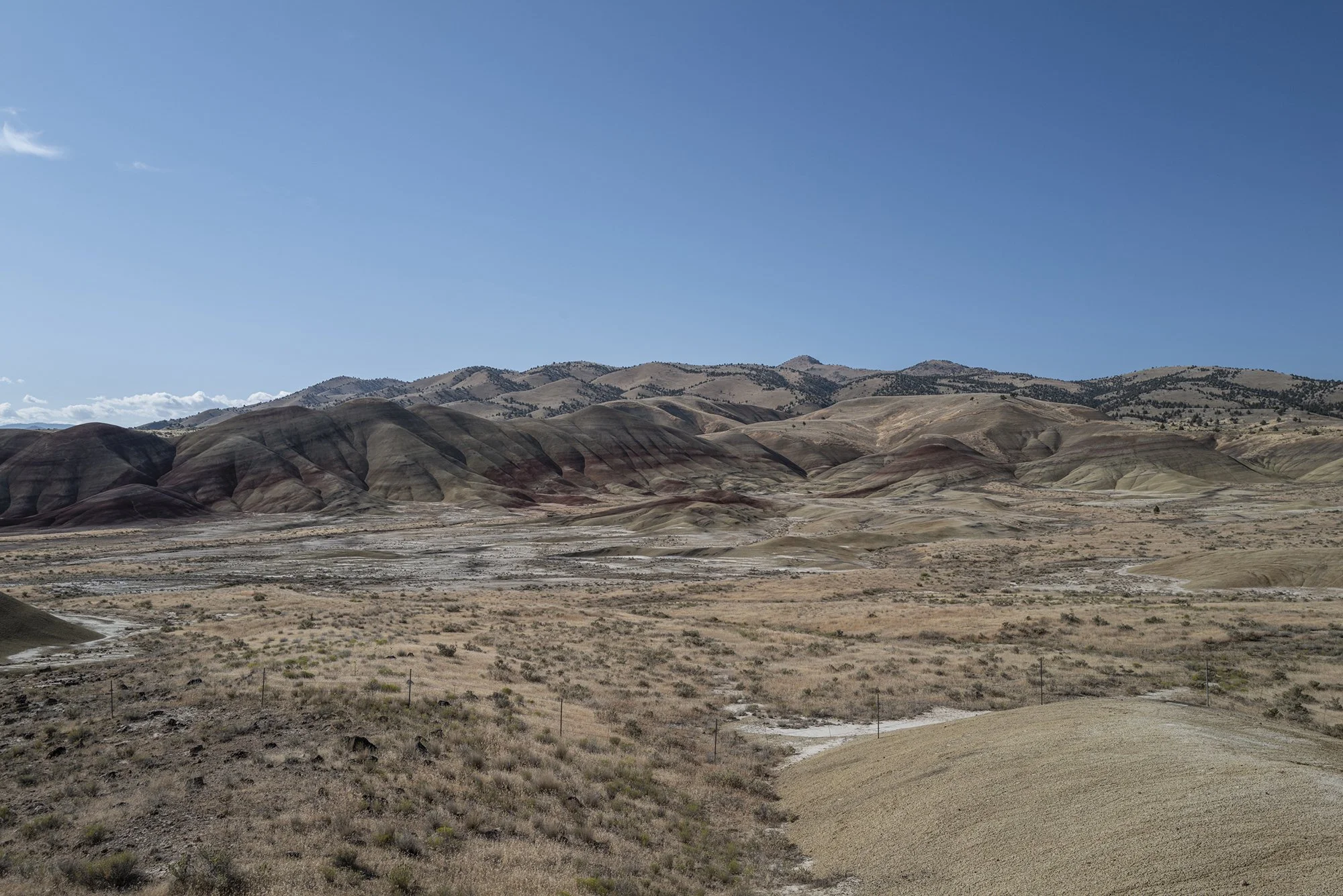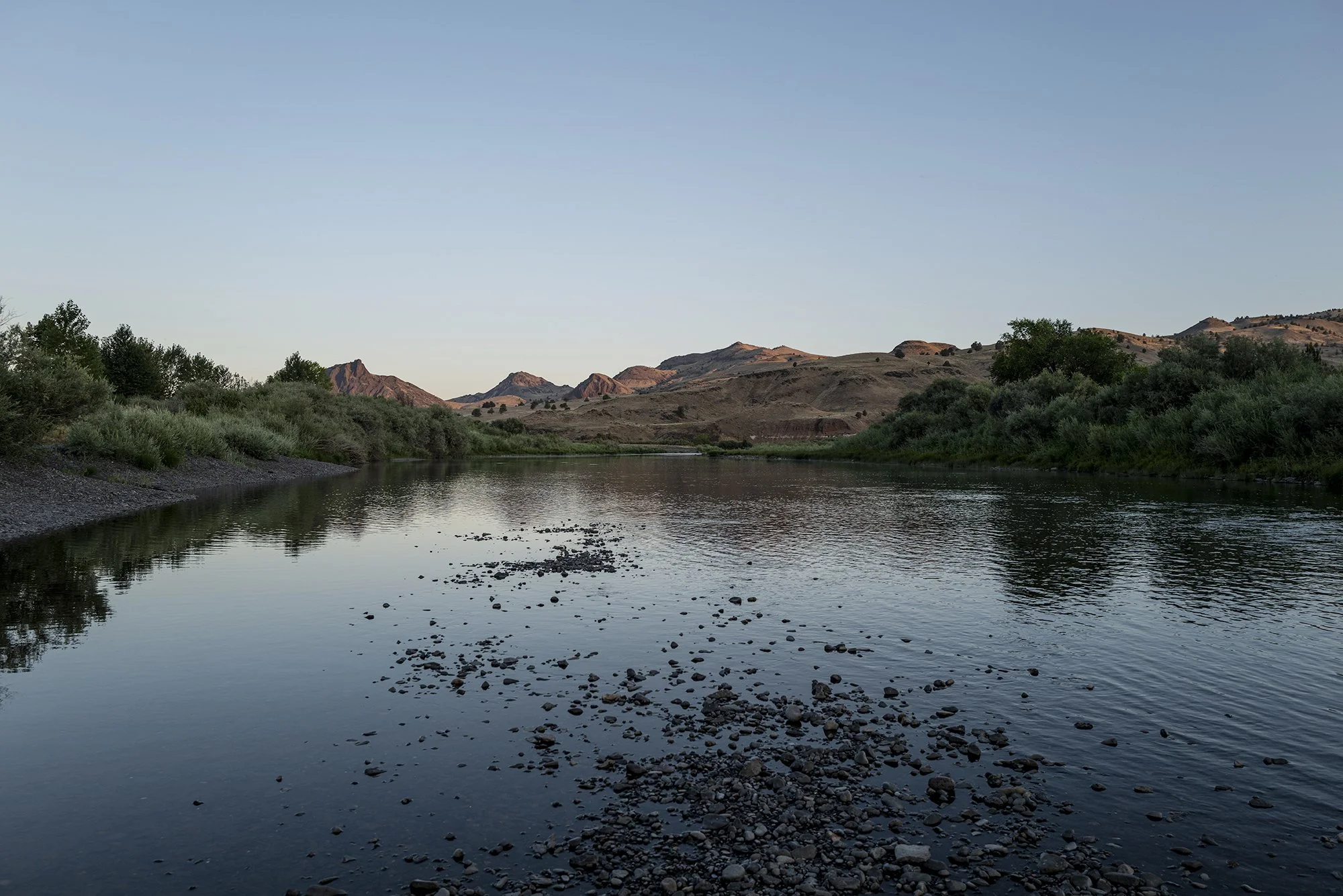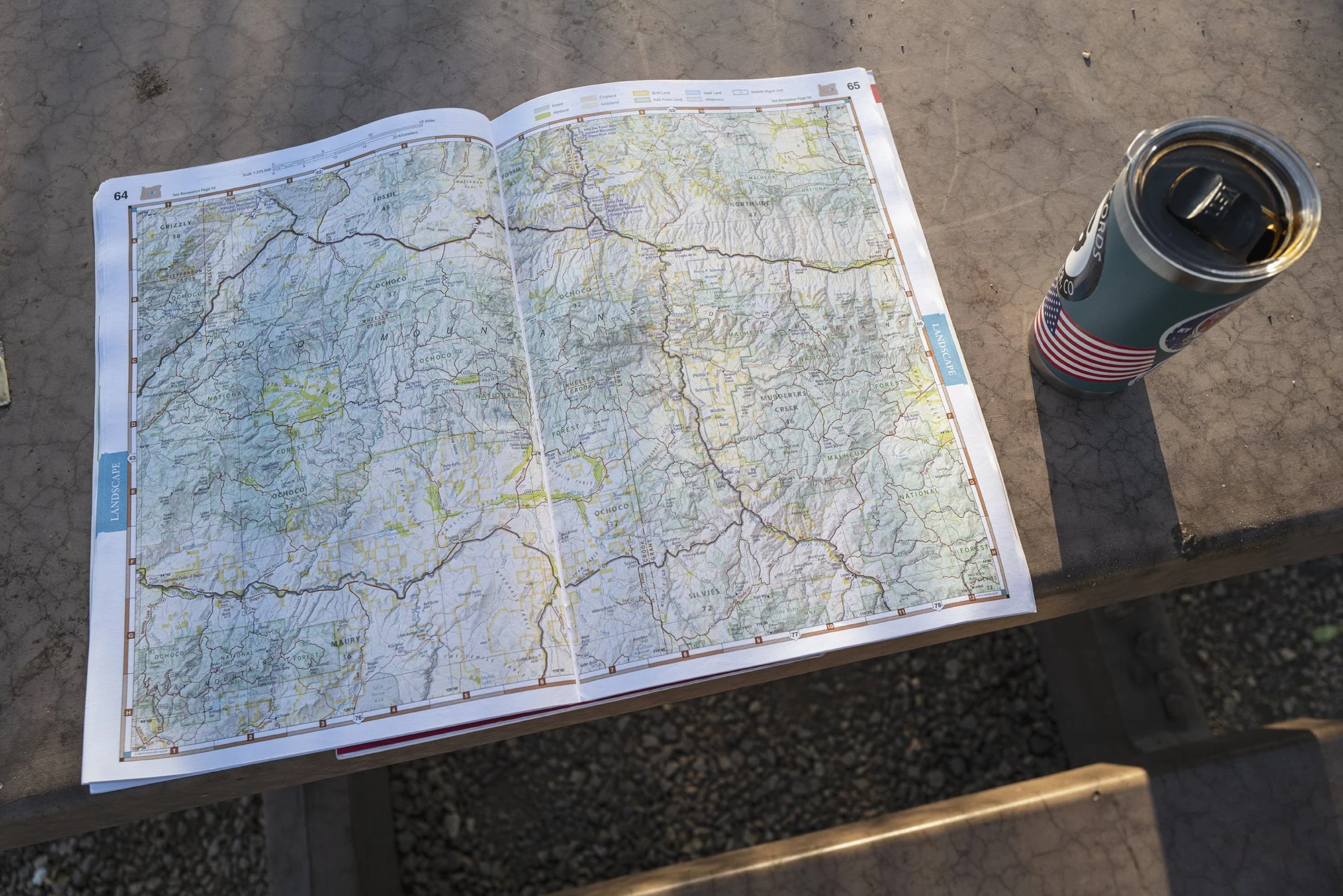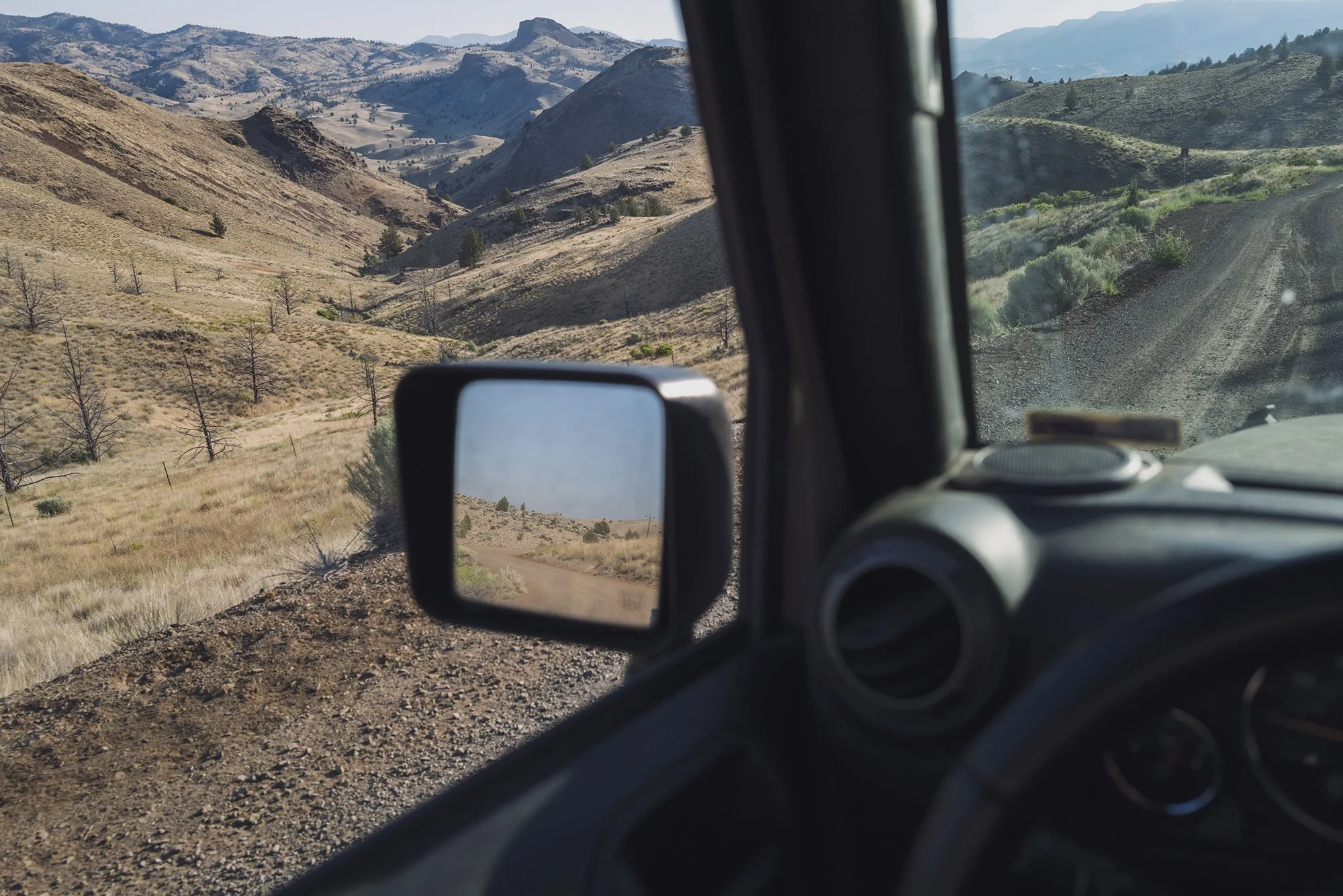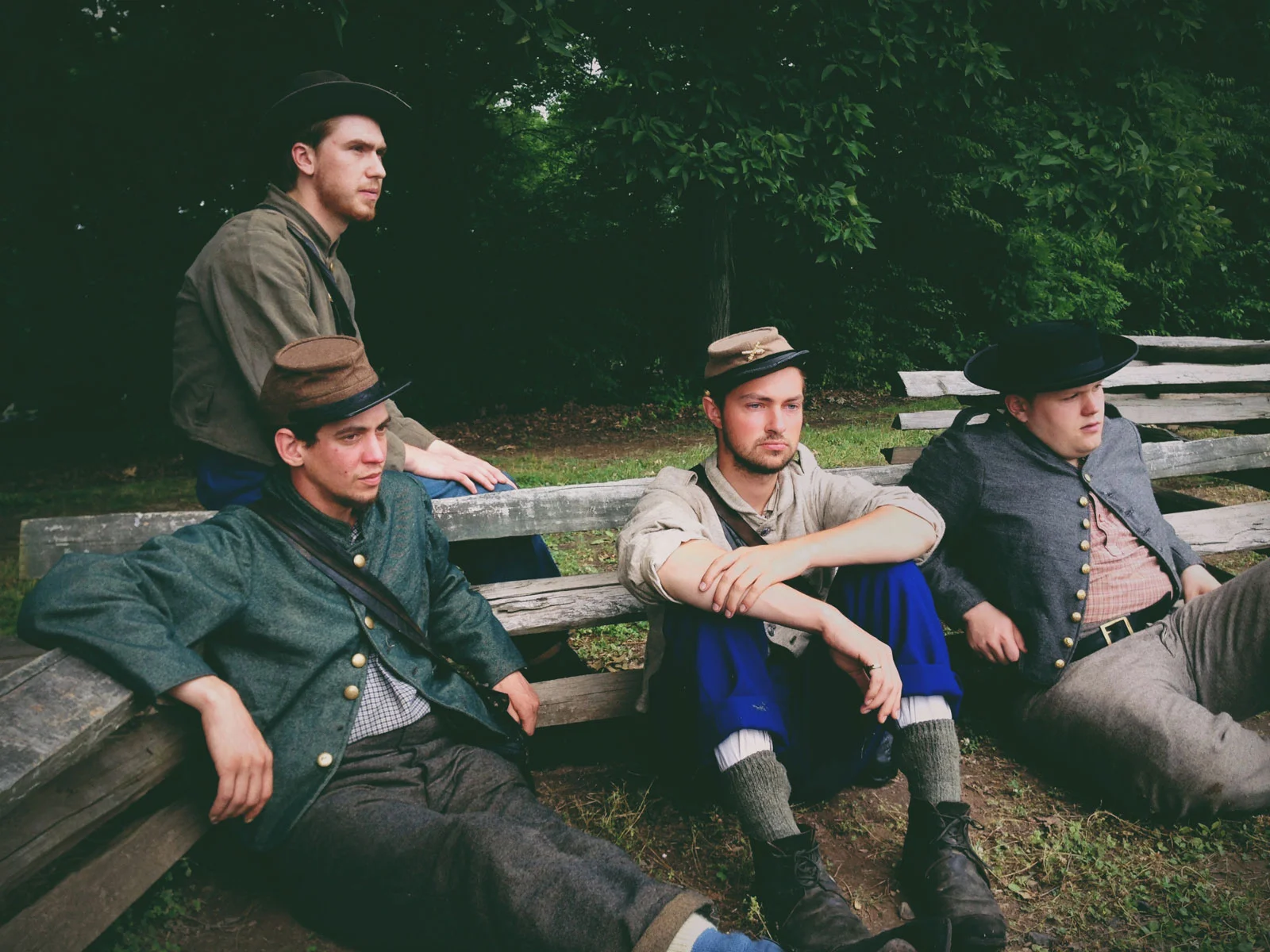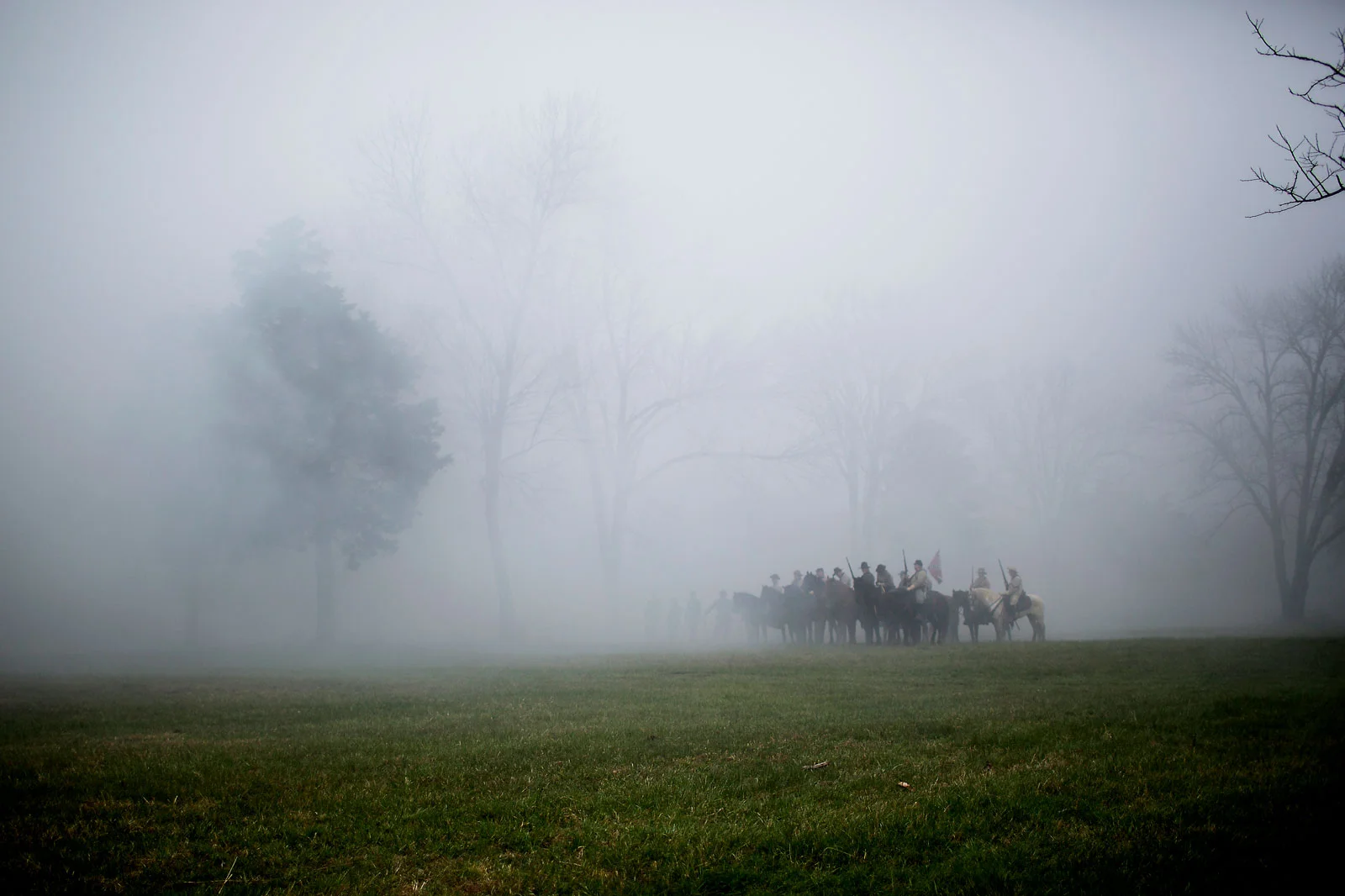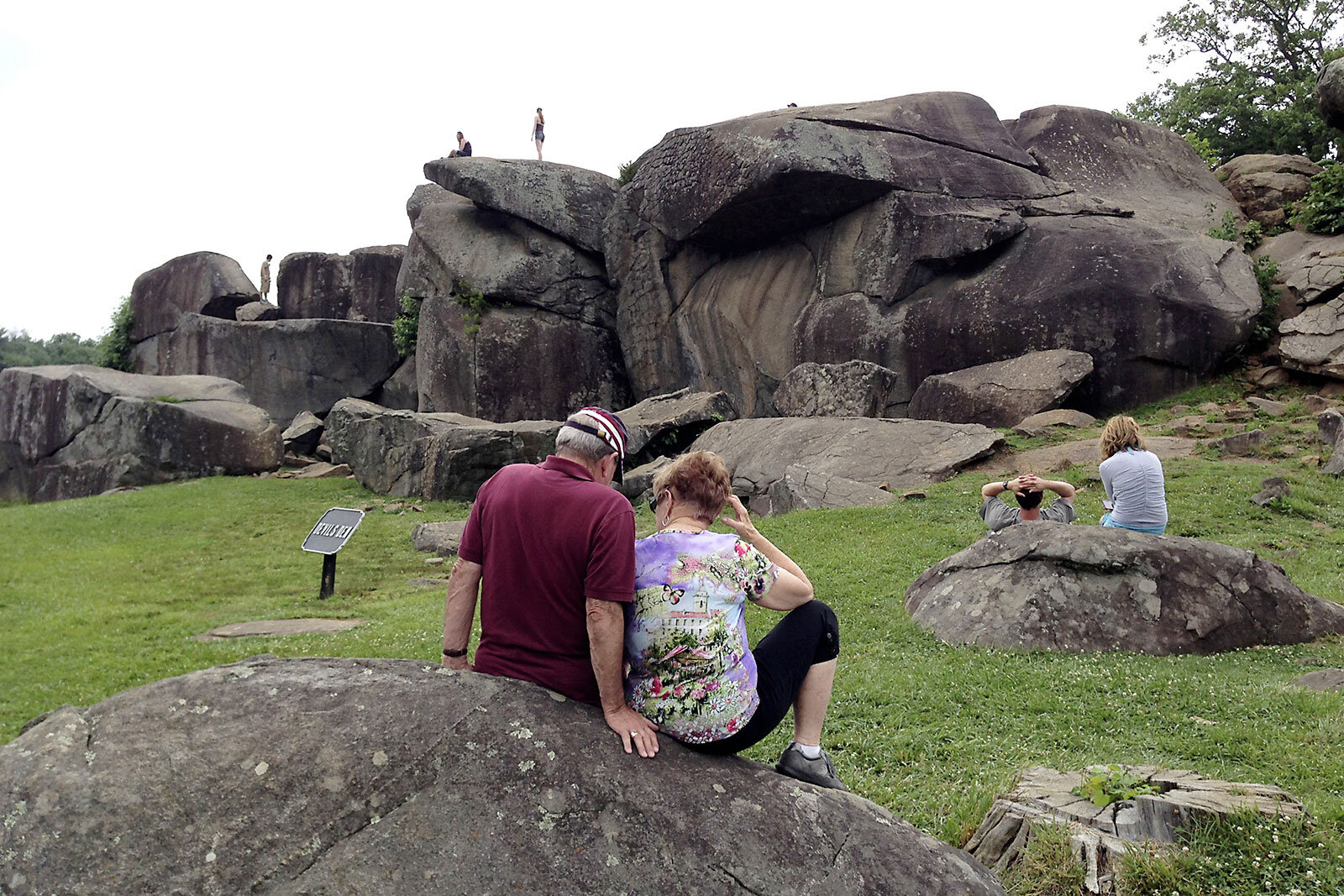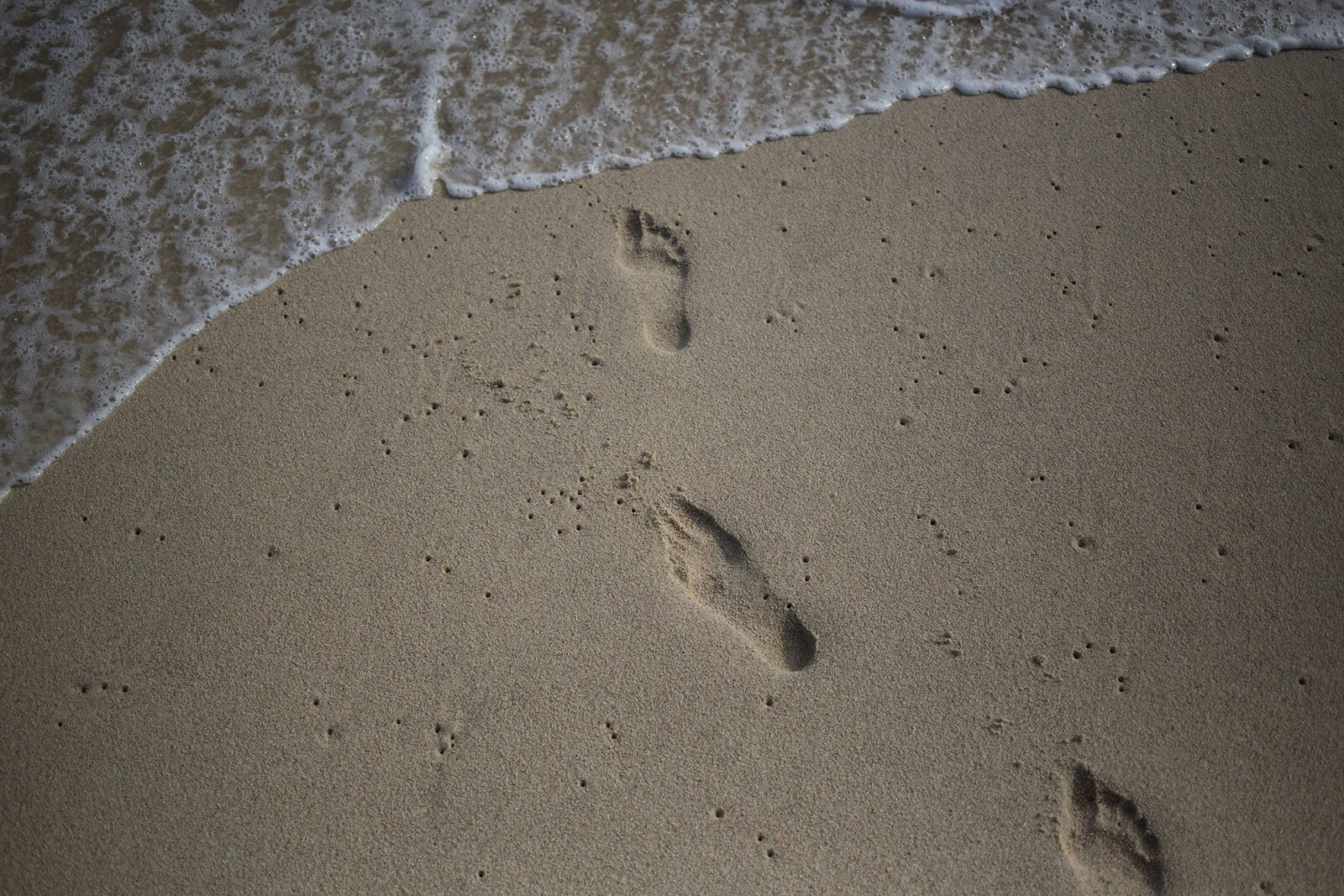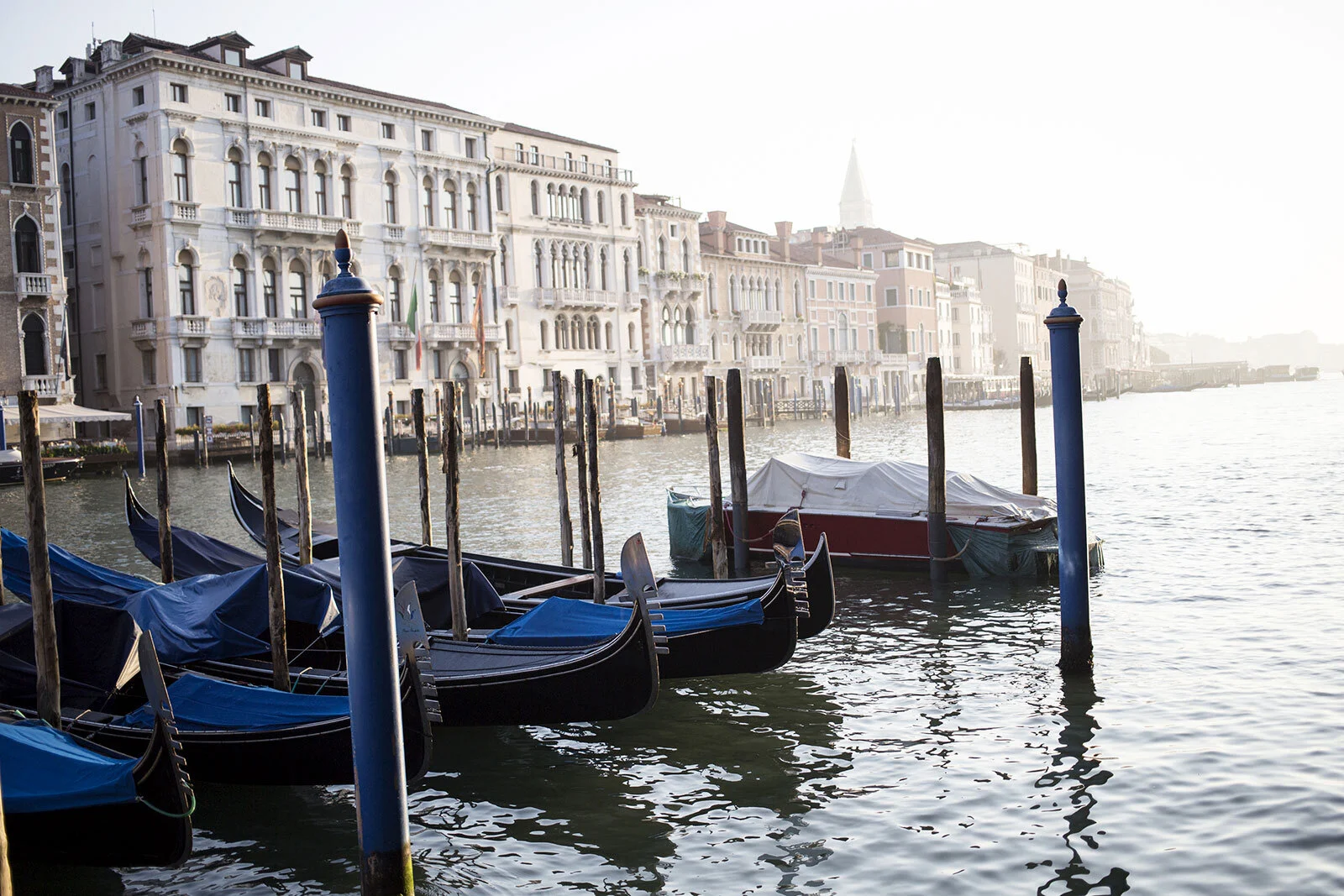Trickster Wild
July 15, 2025
Mitchell, Oregon
Priest Hole
John Day Fossil Beds National Monument, Painted Hills Unit
In the twilight, dry eyes strain at a figure wading across the summer shallows of the John Day River. Just west of the rocky Bend at Priest Hole, the animal blends seamlessly, mist in the blue-gray wildfire smoke that fills the approach through Rattlesnake Canyon, drifting over Cactus Ridge.
To be a coyote — a connoisseur of loneliness — roaming a peaceful yet wild country.
Alpenglow reflecting in the John Day River at John Day Fossil Beds National Monument, Oregon.
Sunset on the John Day is partially blotted out by wildfire smoke.
If you read the river banks, you will see the disintegration of the high wall and clumping of reeds bent by fast-moving or turbulent water. When the water gets high, climb to safety. Can you hear the water rising? Nobody will be your ladder on this solo western adventure; that fact rings in my ears as loud as the wild neighbors.
By nightfall, the lone wanderer has rejoined the pack. The howls come in waves, surrounding me. You're never sure where the call begins, ricocheting and bouncing off hot, dry, molten canyon rock walls that once echoed the footfalls of the first hoofed mammals. The wildfire haze and powdery dust, fossil-rich and ground fine by the river over millennia, swirl in a breeze that keeps the edge off the Dog Days -- the uncomfortable stretch between the summer solstice and the start of fall. In ancient Egypt, Sirius, the Dog Star, symbolizes fertility and renewal of the flooding Nile River. But today, we find the John Day extremely low, with only heat, intensity and transformation along the shoreline.
Part 2 – Bear Dogs & Shifting Climates
Not all intelligence is linear. There's a trickster at the edge of every story out here.
The John Day Formation, which lasted from the Late Eocene to the Oligocene (39 to 23 million years ago), preserved a rich record of mammal evolution in North America. It was a time of dramatic climate change, from warm subtropical forests to more open woodlands and grasslands — a shift reflected in the changing animal life.
This period gave rise to the Amphicyonids, or bear dogs. These early carnivores later diversified into dog- and bear-like forms, neither dogs nor bears. Coyotes (Canidae) and those bear-dog hallucinations aren't direct relatives but share a distant ancestor in the broader Caniformia family tree. The branch broke here about 50 million years ago, with the Amphicyonids falling to the wayside, successful in their time but, in the end, evolutionary rejects.
The coyote appeared a million years ago, first evolving in central North America in the same family as the wolf and fox. It used the iconic howls, yips and barks to mark territory or communicate while adapting to increasingly diverse habitats, including modern urban landscapes. Without human conflict, coyotes can live an average of 10-15 years, mating for life as a symbol of the untamed. Native Americans' traditions and indigenous myth paint the long-legged, greyish-brown animal not only as wise tricksters, creator and destroyer, but as boundary crossers or worlds. Moving freely between realms, physical and spiritual, surviving by adaptability, cunning and resilience, thriving on the border of wilderness and civilization.
A few years ago, not far from camp, a three-legged coyote darted across the road, slipping under acres of barbed wire, openly mocking a rancher's private property sign and disappeared. Coyotes, who know any backroad more than any man, bring order and chaos, the mundane and supernatural. Some believe they die and return, shifting between animal and human while speaking to the gods. They carry the echoes of deep time along river banks and city parks, both hero and fool, with a message of dire warnings.
Part 3 – Predators Make Maps
Borders are drawn in blood and instinct, carving meaning into the land.
Eastern Oregon's terrain is diverse, with rugged ranchlands and public lands stitched across the drastic geography. John Day Fossil Beds National Monument is "one park, three units"—Clarno, Sheep Rock and Painted Hills Units—scattered across the river's expansive watershed, making a one-day trip to tour difficult.
The Painted Hills are a series of dramatic rolling landscapes of clay layers in greys, pinks, purple and yellows. Wooden signs staked into the hard-packed paleosols (fossil soils) offer brief glimpses into the ancient climate they record: red soils reveal a warm, wet period where swamps are typical, blends of yellow clays showcase a cooler, drier time dominated by hardwood forests. Thirty-three million years ago, iron-rich volcanic ash fell here, gradually transforming into fertile soils under forests and swamps.
Even in a timeless topography, the fractures of modern society are unmistakable. In a single breath, the coyote warns of creation and destruction. What starts with a cry—a yip on the wind—shapeshifts into a growl, baring teeth as the first cracks form. These reflections are as undeniable as the pale frame sending ripples downstream.
Deep in a western river basin, views of shifting geological layers are interrupted by thoughts of short-term human interference. We, too, are paradoxical creatures harboring a unique gift: the ability to create complex problems yet invent creative solutions. Born to wander, we rise from the valley, a collection of memories from ancient repetition, fragments of our restless selves. Still, the coyote's warning wail haunts us.
Part 4: Nature Favors Entropy
By morning, the encounter with the coyote is still in my dreams as I pack up camp, slam doors and greet the day with tires on the hardpack gravel road.
Back to reality, where nature has no preference. Left to themselves, natural systems slide toward greater entropy—a steady, predictable slide from order to disorder as they reorganize as sure as the pink and yellow layers stack by unrushed forces.
John Day River. Mitchell, Oregon.
Seattle route planning, morning coffee.
Exiting north through the canyons of John Day Fossil Beds National Monument in Eastern Oregon.
Loping off, the creature fades, tail low, disappearing, faint as a rustle in tall river grass. Remote, yes, deserted, never. The long day is starting to add up. The wind picks up ever so slightly, rises to meet bare arms, fragile against red rocks rich in iron and ore — but never powerless.
Just as my focus sharpens on the journey to Seattle ahead, a spirit catches my eye as it jolts across the road, pausing at an overlook where the sun crests on a wave of crumbling landscape. A puzzle, a million years in the making, tilts a sleek head for a long look back, holding a gaze before vanishing into the borderless wild.
